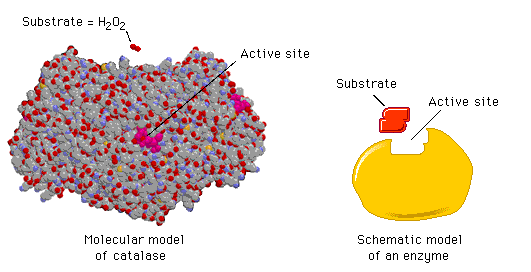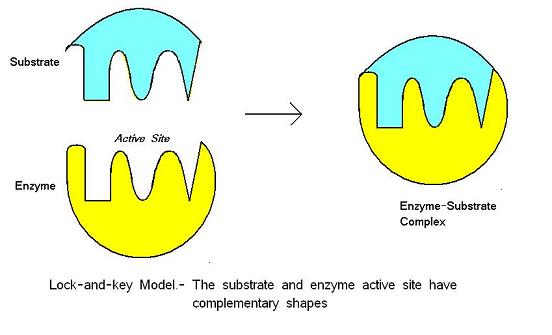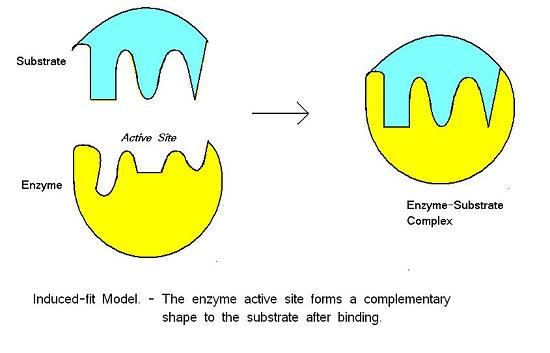Enzymes
Enzymes are Biological Catalysts. They increase the rate of Metabolic reactions. Almost all Biological Reactions involve Enzymes. All enzymes are Globular Proteins with a specific Tertiary Shape. They are usually specific to only one reaction.
The part of the Enzyme that acts a Catalyst is called the Active Site. The rest of the Enzyme is much larger and is involved in maintaining the specific shape of of the Enzyme.
When a reaction involving an Enzyme occurs, a Substrate is turned into a Product. The Substrate can be one or more molecules. The Active Site of an Enzyme is Complementary to the Substrate it catalyses.

- _Some examples of Enzymes are:
- Lactase: Breaks down Lactose into Glucose and Galactose.
- Catalase: Breaks Hydrogen Peroxide down into Water and Oxygen.
- Glycogen Synthase: Catalyses the formation of Glycosidic Bonds between Glucose molecules.
- ATP-ase: Breaks down ATP into ADP, producing energy._
Enzymes in the Real World
Since Enzymes are Proteins, which are effected by their environment, organisms that live in varying conditions have adapted by producing Enzymes more suitable to their environments. Endotherms (animals that maintain their body temperature) keep the temperature of the Enzymes within their bodies constant to ensure optimum rates of reaction.
Enzymes are used for a wide variety of purposes, such as in digestion. The action of an Enzyme may be Intracellular (the Enzymes are attached to the cell membrane or are in the Cytoplasm, and reactions occur inside the cell) or Extracellular (Enzymes work outside cells, and their products may be absorbed into the cell)
Enzymes are also used in protection against Pathogens. They can be used to destroy invading Microorgansims. For example, Phagocytes engulf Pathogens and the Endocytosed Vesicle then fuses with Lysosomes which contain enzymes that destroy the Pathogen’s cell membrane.
How Enzymes Work
- Most reactions in a cell require very high temperatures to get going, which would destroy the cell. Enzymes work by lowering the Activation Energy of a reaction.
- The Activation Energy of a reaction is lowered by putting stress on the bonds within a molecule, or by holding molecules close together. This increases the likelihood of a reaction, and so lowers the energy required to begin it.
The Lock-and-key Hypothesis
The Lock-and-key Hypothesis is a model of how Enzymes catalyse Substrate reactions. It states that the shape of the Active Sites of Enzymes are exactly Complementary to the shape of the Substrate.
When a substrate molecule collides with an enzyme whose Active Site shape is complementary, the substrate will fit into the Active Site and an Enzyme-Substrate Complex will form.
- The enzyme will catalyse the reaction, and the products, together with the enzyme, will form an Enzyme-Product Complex. According to this model, it is possible for an enzyme to catalyse a reverse reaction.

The Induced-Fit Hypothesis
A more recent model, which is backed up by evidence ,and is widely accepted as describing the way enzymes work, is the Induced-Fit Hypothesis. It states that the shape of Active Sites are not exactly Complementary, but change shape in the presence of a specific substrate to become Complementary.
When a substrate molecule collides with an enzyme, if its composition is specifically correct, the shape of the enzyme’s Active Site will change so that the substrate fits into it and an Enzyme-Substrate Complex can form. The reaction is then catalysed and an Enzyme-Product Complex forms.
